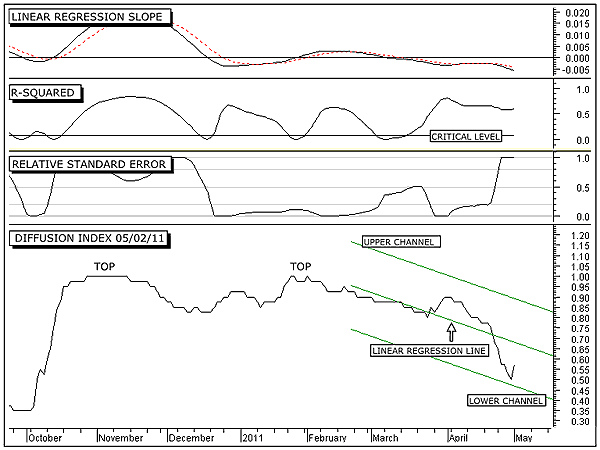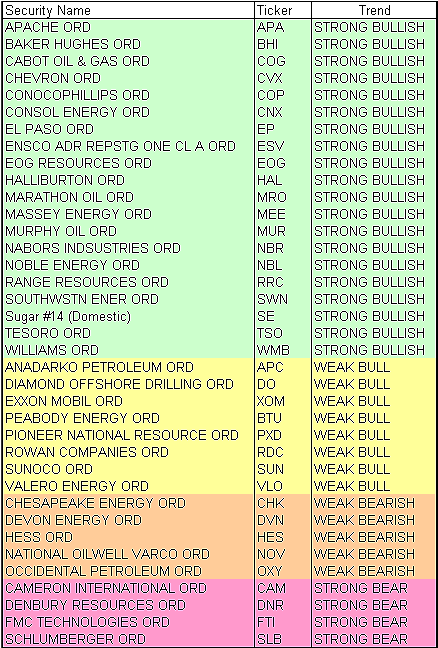
HOT TOPICS LIST
- MACD
- Fibonacci
- RSI
- Gann
- ADXR
- Stochastics
- Volume
- Triangles
- Futures
- Cycles
- Volatility
- ZIGZAG
- MESA
- Retracement
- Aroon
INDICATORS LIST
LIST OF TOPICS
PRINT THIS ARTICLE
by Alan R. Northam
By analyzing the strengths and weaknesses of the individual stocks within XLE, we can see that internally, XLE's health is deteriorating.
Position: N/A
Alan R. Northam
Alan Northam lives in the Dallas, Texas area and as an electronic engineer gave him an analytical mind from which he has developed a thorough knowledge of stock market technical analysis. His abilities to analyze the future direction of the stock market has allowed him to successfully trade of his own portfolio over the last 30 years. Mr. Northam is now retired and trading the stock market full time. You can reach him at inquiry@tradersclassroom.com or by visiting his website at http://www.tradersclassroom.com. You can also follow him on Twitter @TradersClassrm.
PRINT THIS ARTICLE
STATISTICS
XLE Diffusion Index Is Falling
05/04/11 09:33:36 AMby Alan R. Northam
By analyzing the strengths and weaknesses of the individual stocks within XLE, we can see that internally, XLE's health is deteriorating.
Position: N/A
| According to Martin Pring in his classic work "Technical Analysis Explained," a diffusion indicator is an oscillator of a basket of securities that make up an index and often measures the part of the market that is heading up. "An example might be the percentage of the 30 stocks comprising the Dow Jones Industrial Average that are above their 30-day moving averages," Pring notes. |
| The statistical diffusion indicator in Figure 1 is an oscillator that moves between zero and 100% with 40 stocks representing the number of securities making up the Select Sector SPDR ETF (XLE). The indicator measures the number of stocks within XLE whose 50-day linear regression slope indicator is above zero and whose 50-day R-squared indicator is above its critical level. Thus, this statistical diffusion indicator is made up of a basket of stocks that individually are in strong intermediate-term uptrends. The current reading of 0.57 indicates that 57% of the stocks within XLE are still in strong uptrends. The balance of stocks making up XLE are either in weak uptrends, weak downtrends, or in strong bear market trends. In the lower panel of Figure 1, note that from early November 2010 to late January 2011, the diffusion index is forming a double-top pattern. Following the completion of the double top, XLE started a downtrend. A 50-day linear regression trendline along with its upper and lower two sigma channel lines has been added to the chart to measure this downtrend. Note that recently, the diffusion index moved down to the lower channel boundary and is now bouncing upward. Two things are of interest about this low point. First of all, it measured 0.5, indicating that 50% of all stocks within XLE were in strong uptrends and the other 50% were not. A move below 50% would indicate that the minority of stocks within XLE remain in strong uptrends, a bearish sign. Second, this low point shows that the lower linear regression channel line is acting as a strong line of support. I would now expect the diffusion index to move back up to the linear regression line (middle green line). |

|
| FIGURE 1: XLE DIFFUSION INDEX, DAILY. This figure shows the XLE diffusion index, a completed double-top pattern, and the linear regression trendline along with its upper and lower channel lines. This figure also shows the linear regression slope indicator, the R-squared indicator, and the RSEI. |
| Graphic provided by: MetaStock. |
| |
| The top panel in Figure 1 is the linear regression slope indicator. This indicator crossed below its zero line in early March, signaling the beginning of the downtrend for the diffusion index. Note that this indicator continues to point in a downward direction, signaling a further decline in the diffusion index. The second panel from the top is that of the R-squared indicator. This indicator measures the strength of the trend. In early March, this indicator reached 80%, indicating a strong downtrend. Since that time, the strength of the trend has backed off some but still remains above 50%. The third panel from the top is the relative standard error index (RSEI). This index is currently at 100%, signaling an extreme level of volatility. High levels of volatility normally occur at the end of a trend, and this indicator is warning that the downtrend in the diffusion index may be coming to an end. |
| Figure 2 is a table showing the current strengths and weaknesses of the 40 stocks making up the Select Sector SPDR ETF (XLE). This table was created based upon signals generated by a statistical analysis of a sample of the 50-day closing prices made at the recent low value of the diffusion index. This table shows the 20 stocks within XLE that remain in strong bull market trends. It also shows that eight stocks remain in weak bull market trends, five stocks are in weak bear market trends, and four stocks are in strong bear market trends. While 50% of the stocks continue to remain is strong bull market trends this table shows a bearish tendency in the bullish stocks, turning into weak bearish stocks, and then turning into strong bearish stocks. A more bullish tendency would be to see fewer weak bullish stocks and more weak bearish stocks. |

|
| FIGURE 2: XLE 40 STOCKS. This table shows the current trends of each of the 40 stocks making up XLE highlighted in different colors. |
| Graphic provided by: Microsoft Excel. |
| |
| In conclusion, the statistical analysis of the XLE Diffusion Index shows that the number of bullish stocks that make up XLE is declining. The analysis also shows that a bounce back up to the linear regression line could now be under way. However, this bounce will not change the direction of the diffusion index unless it manages to rally through the linear regression line and break out above the upper channel line. Following the bounce, should the diffusion index turn back downward at the linear regression line and below 0.50, it will signal that less than 50% of the stocks within XLE remain in bullish trends. This could then mark the top of the bullish rally for XLE. Keep in mind, however, that even with fewer than 50% of the remaining stocks in bullish trends, XLE could still push somewhat higher before reaching an ultimate top and turning downward. In my opinion, the easy profits in the energy sector has already been made. From here on out, XLE will most likely find it much more difficult to keep on pushing out those profits and could turn down now at any time. |
Alan Northam lives in the Dallas, Texas area and as an electronic engineer gave him an analytical mind from which he has developed a thorough knowledge of stock market technical analysis. His abilities to analyze the future direction of the stock market has allowed him to successfully trade of his own portfolio over the last 30 years. Mr. Northam is now retired and trading the stock market full time. You can reach him at inquiry@tradersclassroom.com or by visiting his website at http://www.tradersclassroom.com. You can also follow him on Twitter @TradersClassrm.
| Garland, Tx | |
| Website: | www.tradersclassroom.com |
| E-mail address: | inquiry@tradersclassroom.com |
Click here for more information about our publications!
Comments

|

Request Information From Our Sponsors
- StockCharts.com, Inc.
- Candle Patterns
- Candlestick Charting Explained
- Intermarket Technical Analysis
- John Murphy on Chart Analysis
- John Murphy's Chart Pattern Recognition
- John Murphy's Market Message
- MurphyExplainsMarketAnalysis-Intermarket Analysis
- MurphyExplainsMarketAnalysis-Visual Analysis
- StockCharts.com
- Technical Analysis of the Financial Markets
- The Visual Investor
- VectorVest, Inc.
- Executive Premier Workshop
- One-Day Options Course
- OptionsPro
- Retirement Income Workshop
- Sure-Fire Trading Systems (VectorVest, Inc.)
- Trading as a Business Workshop
- VectorVest 7 EOD
- VectorVest 7 RealTime/IntraDay
- VectorVest AutoTester
- VectorVest Educational Services
- VectorVest OnLine
- VectorVest Options Analyzer
- VectorVest ProGraphics v6.0
- VectorVest ProTrader 7
- VectorVest RealTime Derby Tool
- VectorVest Simulator
- VectorVest Variator
- VectorVest Watchdog
